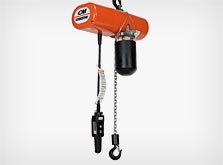 Hoists and balancers are attachments for bridge cranes and other material handling equipment that are used to lift heavy loads. Relatively simple in design, they provide stability and increased mobility and come in a wide range of capacities and can be used for a variety of purposes.
Hoists and balancers are attachments for bridge cranes and other material handling equipment that are used to lift heavy loads. Relatively simple in design, they provide stability and increased mobility and come in a wide range of capacities and can be used for a variety of purposes.
A hoist consists of a power source, a drive mechanism that turns a lift wheel or sprocket, and a length of chain or wire rope, known as the lift media. When power is supplied to the hoist, the drive mechanism turns the sprocket, which retrieves or extends the lift media. This, then, raises or lowers the payload. In most cases, the up and down functions are controlled by a hand-held pendant with buttons or levels for each direction.
Pneumatic Balancers vs. Electric Hoists
Similar in design, a balancer is a pneumatically-powered device that can be controlled to raise or lower a heavy payload based on physical input from the operator. For example, assume an operator wants to lower a hook that is attaché to the end of the balancer chain and attach it to a payload. Rather than having to hold the pendant in one hand and the chain in the other, the operator can simply pull down on the chain with a small amount of input force. The balancer’s controls sense the input and let the operator lower the hook. Once the hook is attached to the payload, the operator gives a little up force on the chain and the balancer responds by raising the payload.
Hoist and balancers are either electric or pneumatic. Electric hoists don’t require any type of airtight sealing, unlike pneumatic balancers. Electric power turns a gear set or sprocket, powering the device. Gearing allows high-speed smaller motors to generate large amounts of torque at low speeds. Similar to lift tables, electric hoists commonly are rated to lift loads of 2,000 lbs. or more.
Load Size Determines Which Equipment Is Best
Pneumatic balancers, on the other hand, are slightly more complex. Air is introduced into a cylinder, usually at between 80 and 90 pounds per square inch (psi). A piston in the cylinder is then forced from one side to the other. As the piston head moves, a ball screw is turned, which causes the payload to be lifted.
Capacities of pneumatic balancers tend to be lower than electric hoists, generally topping out at about 500 lbs.
Bahrns carries a wide variety of electric hoists and pneumatic balancers, as well as parts and accessories.
